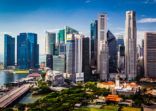“There could be a lot of disappointment if we start to get weak growth in the US,” Pierre DeGagné, head of funds selection at DBS Private Bank in Singapore, told FSA.
“We want to be in the highest-growth places in the market, and not in stuff that’s been run up by ETFs – if markets turn and investors run, a lot of money will be flowing out of ETFs and it’s going to be indiscriminate.”
DeGagné did not hold strong concerns about the US-China trade dispute, which causes investor sentiment to ebb and flow depending on headlines. He affirmed that the bank is generally bullish on China equities.
“We want to buy the best companies in China for the long-term. The [trade dispute] noise makes for some opportunity there, and we see opportunity in India. We want to be long-term in both markets.”
Allocation adjusted
He laid out the bank’s portfolio allocation. DBS uses a barbell investment strategy, specifically growth and income on each end, avoiding “anything that is not in top-quartile of either of these two groups”, he said.
“This balance of the growth and shield structure are areas we are most keen on. We’re not so keen on big broad market or ETF-type investments.”
DBS is neutral on equities in general. However, there’s a bias toward US and Asian equities and by sector, healthcare and technology. European risk seems to be priced in, he said, but the Brexit outcome could be more painful than people expect.
On the income side, the bank prefers and Asia high dividend equities and Asia real estate investment trusts (Reits), which he said have seen high inflows.
Turning to fixed income, he said client demand remains. But DeGagné sees a key investment risk in credit and the bank has made some adjustments.
The most recent change is trimming some credit exposure to bring in the Allianz Global Opportunistic Bond Fund, which has a nearly 70% allocation to AAA-rated bonds, the factsheet shows.
“We have a strong bias to aggregate type of products as opposed to high yield products,” he said.
“We are slightly overweight on credit. We’ve been trying to get clients more toward government bonds, which have had a low allocation.”
He warned on negative interest rate bonds, which investors would likely get exposure to via bond ETFs.
“The US, Norway, Australia and New Zealand are some of the government bonds [with satisfactory yields]. We look for managers who can go into those spaces and also do relative value trades along the curve to make money. That’s where we think there is alpha to be generated.
“A straight buy-and-hold strategy will not make you too much money in government bonds today.”
In alternatives, he likes some Ucits hedge funds, but the standout is gold, both bullion and gold miners. For example, the bank is distributing the Merian Gold and Silver Fund.
“Since September last year we have been particularly keen on gold,” DeGagné said. “Gold is a good diversifier and cheap hedge for risk, and I see it having aspects which could do well regardless of market direction.”
Seeking ESG with growth
ESG products, more specifically environmental equities and social impact funds, are included on the growth side of the bank’s barbell strategy.
Some growth-oriented impact funds are relatively cheap compared to the tech sector, for example, he said.
ESG products on the bank’s platform include the Parvest Environmental Fund, run by Impax, which is mostly mid-cap industrials and the Wellington Impact Fund, mostly invested in impact-oriented companies with an emerging markets bias.
Additionally, the First State Dividend Fund is included as a governance manager on the growth end of the barbell model as well as the Walters Scott BNY Long Term Equity Fund. In October, the bank is planning to add a sustainable bond income fund, he added.
DeGagné said the bank aims to select ESG products that are expected to outperform broader benchmarks over the mid-term. The Wellington Impact Fund, for example, is outperforming its reference benchmark, the MSCI AC World and the sector year-to-date, according to FE data.
“These products are hard to find because so much of that space is dominated by many ‘ESG products’ that are without benchmarks and do not meet our strict quality selection.
“Our clients of the future are going to expect, at the least, transparency on ESG. We want to be prepared for that demand when it gets here, but we can’t compromise returns.”

















